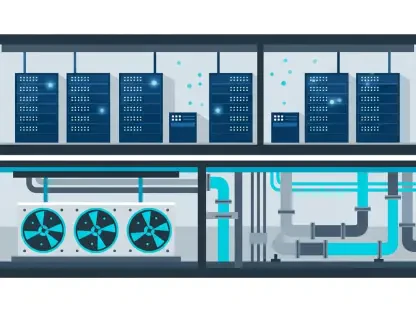Setting the Stage for Offshore Connectivity
Imagine a vast, isolated expanse of ocean where massive oil rigs and floating production units operate under the harshest conditions, cut off from traditional communication networks, and where a single delay in data transmission can halt operations or jeopardize safety. In such environments, the offshore oil and gas industry has long grappled with connectivity challenges, but a transformative solution has emerged in the form of private 5G networks. These dedicated, high-speed systems are redefining how remote maritime assets function, promising low-latency communication and robust reliability. This review delves into the cutting-edge realm of offshore private 5G, spotlighting deployments in the North Sea as a benchmark for industrial innovation.
The significance of this technology lies in its ability to bridge the digital divide in environments where conventional Wi-Fi falters due to physical barriers like steel structures. With the industry pushing toward automation and real-time data analytics, the demand for seamless connectivity has never been greater. Private 5G networks offer a tailored approach, ensuring secure and efficient communication for critical operations. This analysis focuses on the pioneering efforts of Tampnet, a Norway-based specialist, whose projects provide a lens through which to evaluate the potential and challenges of this technology.
Diving into the Technology
Architecture and Performance of Private 5G
At the heart of offshore private 5G networks is a bespoke architecture designed for industrial-grade reliability. Unlike public networks, these systems are dedicated to specific assets, ensuring secure connectivity without interference. They deliver exceptional performance metrics, including ultra-low latency and high bandwidth, which are vital for real-time applications in offshore settings. Tampnet’s deployments, leveraging technology from Nokia and Hewlett Packard Enterprise (HPE), exemplify how such networks support complex operations on rigs and floating units.
The ability to maintain consistent communication in remote locations sets private 5G apart from older solutions. High-speed data transfer enables instantaneous updates for monitoring systems, while low latency ensures that remote control of machinery remains precise. This performance is particularly critical in environments where split-second decisions can prevent costly downtime or accidents. The tailored nature of these networks also enhances cybersecurity, protecting sensitive operational data from external threats.
Hybrid Backhaul for Seamless Reach
A key enabler of offshore 5G is the use of hybrid backhaul solutions, blending low-earth-orbit (LEO) satellite systems like Starlink and OneWeb with LTE, fiber, or microwave connections. This combination addresses the geographical isolation of offshore assets, ensuring uninterrupted connectivity despite challenges like vast distances or physical obstructions. Tampnet’s projects with Island Drilling and Vår Energi demonstrate how hybrid backhaul overcomes the limitations of traditional setups in the North Sea.
These solutions are engineered to adapt to the unique constraints of maritime environments. Steel structures on rigs often disrupt signals, but hybrid systems reroute data through multiple pathways to maintain stability. The flexibility of LEO satellites, offering broader coverage than conventional options, plays a pivotal role in linking remote assets to onshore hubs. Such resilience is essential for maintaining operational continuity under unpredictable conditions.
Edge Computing as a Game-Changer
Complementing private 5G is the integration of edge computing, which processes data locally rather than relying on distant cloud servers. This capability is crucial for offshore operations, where real-time insights drive predictive maintenance, remote assistance, and even autonomous systems. By minimizing latency, edge computing ensures that critical decisions are made swiftly, enhancing both efficiency and safety.
Tampnet’s deployment on the Jotun FPSO, operated by Vår Energi, showcases edge computing’s impact through local compute power supporting edge AI applications. This setup enables instant analysis of equipment data, reducing the risk of failures before they occur. Furthermore, it facilitates digital tools for field workers, streamlining tasks that once required manual intervention. The synergy between 5G and edge computing marks a significant leap toward smarter offshore workflows.
Real-World Impact and Innovations
North Sea Deployments Leading the Way
Tampnet’s partnerships in the North Sea offer a practical glimpse into private 5G’s transformative potential. With Island Drilling, the Island Innovator rig benefits from a managed 5G network that supports mobility for personnel, drones, and robotics. Applications like augmented reality (AR) and digital twins enhance operational precision, while hybrid backhaul ensures connectivity in harsh weather conditions across multiple regions.
In parallel, the collaboration with Vår Energi on the Jotun FPSO introduces full wireless coverage paired with edge AI. This setup, a first for FPSOs, powers the “digital field worker” initiative, equipping staff with tools for safer and more efficient tasks. The project also tackles signal interference from steel structures, setting a new standard for production units. Both initiatives underscore how tailored connectivity drives data-driven decision-making in challenging environments.
Industry Shifts and Emerging Trends
Beyond specific projects, the offshore sector is witnessing a broader digital transformation fueled by private 5G. The growing reliance on LEO satellite technology reflects an industry-wide need for robust backhaul in remote locations. This trend aligns with a push toward automation, where AI-driven operations and digital twins optimize asset performance and reduce human risk.
Innovations in network management, such as AI-orchestrated systems seen in Tampnet’s offerings, further enhance reliability through proactive monitoring and service guarantees. The shift away from outdated Wi-Fi systems highlights a consensus that high-speed, low-latency communication is now indispensable. As these technologies mature, they pave the way for fully autonomous rigs and expanded industrial AI applications.
Challenges in Deployment
Technical and Environmental Hurdles
Despite its promise, deploying private 5G offshore is not without obstacles. Signal interference from steel structures on rigs and FPSOs remains a persistent issue, often disrupting connectivity. Additionally, the complexity of integrating hybrid backhaul systems demands meticulous planning to ensure seamless data flow across diverse channels. These technical barriers require innovative engineering to maintain network stability.
Environmental factors compound the challenge, as harsh weather and remote locations test the durability of equipment. Ensuring consistent performance under such conditions necessitates robust hardware and adaptive solutions. Tampnet’s approach, incorporating managed services and round-the-clock support, offers a model for mitigating these technical difficulties through proactive oversight.
Regulatory and Logistical Constraints
Beyond technology, regulatory frameworks and logistical issues pose significant hurdles. Maritime environments are subject to strict compliance standards, which can delay network rollouts or complicate installations. Coordinating deployments across international waters adds another layer of complexity, requiring alignment with multiple jurisdictions.
Logistical challenges, such as transporting equipment to distant assets, further strain resources. Tampnet and its partners are addressing these issues by streamlining operations and leveraging established technology providers for scalable solutions. However, overcoming these barriers remains an ongoing effort, critical to broader adoption across the industry.
Reflecting on the Journey and Looking Ahead
Looking back, the exploration of offshore private 5G networks reveals a technology that has already begun to redefine the oil and gas industry in remote maritime settings. Tampnet’s deployments in the North Sea, particularly with Island Drilling and Vår Energi, demonstrate how high-speed, low-latency connectivity paired with edge computing tackles longstanding challenges of isolation and inefficiency. The verdict is clear: private 5G stands as a cornerstone for digital transformation, offering unmatched reliability and enabling advanced applications that elevate safety and operational intelligence.
Moving forward, the industry must prioritize scalable solutions to extend these benefits to more regions and assets. Investing in standardized frameworks for hybrid backhaul and edge integration could accelerate adoption, while collaborative efforts between operators and technology providers might address regulatory bottlenecks. As automation and AI continue to evolve, stakeholders should also explore pathways to fully autonomous operations, leveraging private 5G as the backbone for innovation. The journey ahead holds immense potential, provided the sector commits to overcoming deployment hurdles with strategic planning and technological ingenuity.









